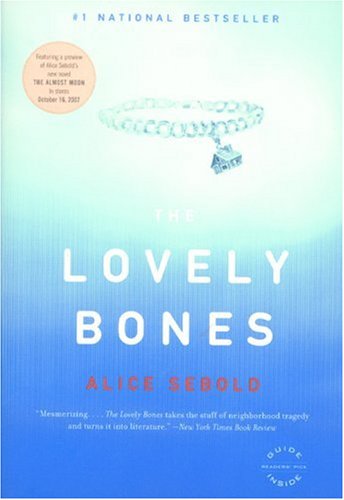All Nonfiction
- Bullying
- Books
- Academic
- Author Interviews
- Celebrity interviews
- College Articles
- College Essays
- Educator of the Year
- Heroes
- Interviews
- Memoir
- Personal Experience
- Sports
- Travel & Culture
All Opinions
- Bullying
- Current Events / Politics
- Discrimination
- Drugs / Alcohol / Smoking
- Entertainment / Celebrities
- Environment
- Love / Relationships
- Movies / Music / TV
- Pop Culture / Trends
- School / College
- Social Issues / Civics
- Spirituality / Religion
- Sports / Hobbies
All Hot Topics
- Bullying
- Community Service
- Environment
- Health
- Letters to the Editor
- Pride & Prejudice
- What Matters
- Back
Summer Guide
- Program Links
- Program Reviews
- Back
College Guide
- College Links
- College Reviews
- College Essays
- College Articles
- Back
The Lovely Bones by Alice Sebold
In The Lovely Bones, Alice Sebold creates a clear and beautiful story of a young girl named Susie Salmon who watches her family from heaven after she is raped and murdered by a neighbor. Sebold is a successful author, who has received several awards for her work, including the American Booksellers Association Book of the Year Award for Adult Fiction, and the Bram Stoker Award for First Novel. Reflecting upon her experience as a rape victim in college, Sebold provides The Lovely Bones as a fictional follow-up to her memoir, Lucky.
Sebold is successful in describing her interpretation of the aftermath of a crime, as she explores not only the thoughts and actions of the victim, but also those of the victim’s friends, family, and murderer. Using the unique point of view of first person omniscient, the story is narrated by the murder victim, Susie Salmon. Susie explains her murder, the events leading up to it, and her experiences in heaven. The majority of the book focuses on Susie’s reflection of the thoughts and actions of her friends and family as she watches them from afar. Although The Lovely Bones is told from the point of view of a murder victim, Sebold prevents the novel from becoming abundantly unrealistic. Her interpretation of heaven is diplomatic; she does not depict gods or angels. Instead, she explains that heaven is different for everyone, and that people meet each other after death when their ideas heaven “had a lot of the same things going on inside” (Sebold 17). Sebold evades the idea of religion altogether, and thus the idea of Susie’s heaven has become quite controversial to many readers; however, Sebold’s interpretation of a godless heaven does not truly hinder the story. As Susie looks down on the planet she left behind, she is able to watch her heartbroken family in the aftermath of her disappearance. Perhaps the most compelling character in the novel is her father, who is the most visibly crushed by her death. He experiences several emotional lapses in the novel; in one such instance, he breaks down in his study where he used to build ships in bottles with Susie. She had been his eldest daughter, and the only one of his children who expressed an interest in building the ships with him. Susie watched from heaven as he smashed each bottle. Finding himself encircled by the ships, he began thinking about “…all the years they had marked and the hands that had held them… He christened the walls and wooden chairs with the news of [Susie’s] death, and afterward he stood in the guest room/den surrounded by the green glass” (Sebold 46). Mr. Salmon’s repeated attempts to cope with his daughter’s death, along with his simultaneous efforts to save his crumbling marriage and destroy Susie’s murderer, make up some of the most breathtaking scenes in the novel. Sebold’s interpretation of a grieving father in the face of a child’s disappearance is remarkable. Although each character is emotionally developed, Susie’s father is by far the most complex and authentic.
Overall, The Lovely Bones is an incredible, believable novel. However, it appears that Sebold may have written the ending of the story in a rush to meet a publishing deadline. She leaves no room for the reader to decide the fate of the characters, and instead tells the reader that everyone goes on to live a happy life, save for Mr. Harvey, the murderer, who dies alone and unnoticed. Although it is nice to know that Sebold decided to let everyone live happily ever after, each character’s fate is irritatingly obvious with no room for surprise. For example, Mr. Harvey’s death is foreshadowed by earlier events in the novel, and Susie’s sister Lindsey insipidly marries her high school sweetheart and goes on to have a daughter who she names after Susie. Also, Sebold repeatedly pushes the idea that each character simply moved on from Susie’s death in the last six pages of the novel. Although nearly the entire novel centers around the inconsolability of Susie’s family after her death, Sebold chooses the last chapter to be offhandedly and unintentionally ironic, saying that “Being together, thinking and talking about the dead, became a perfectly normal part of their life” (Sebold 324, 325). Despite the compelling storyline within its first three hundred pages, the ending of this novel inexplicably suffers from a serious lack of imagination.
Alice Sebold’s The Lovely Bones is a spectacular story that many readers can enjoy. Although the ending of the novel is in need of revision, as a whole, the story is beautifully crafted. Sebold creatively explores many different points of view in the face of a tragedy through relatable characters and a wonderful storyline.
Similar Articles
JOIN THE DISCUSSION
This article has 0 comments.

